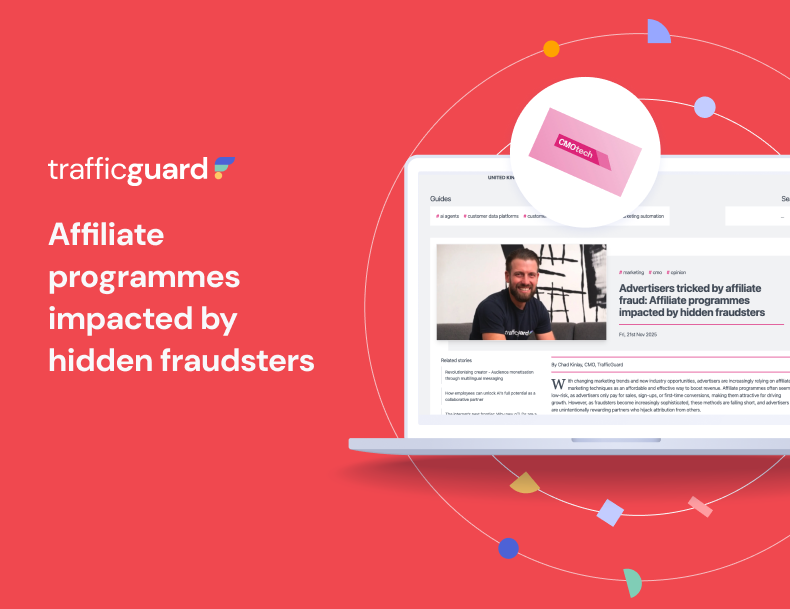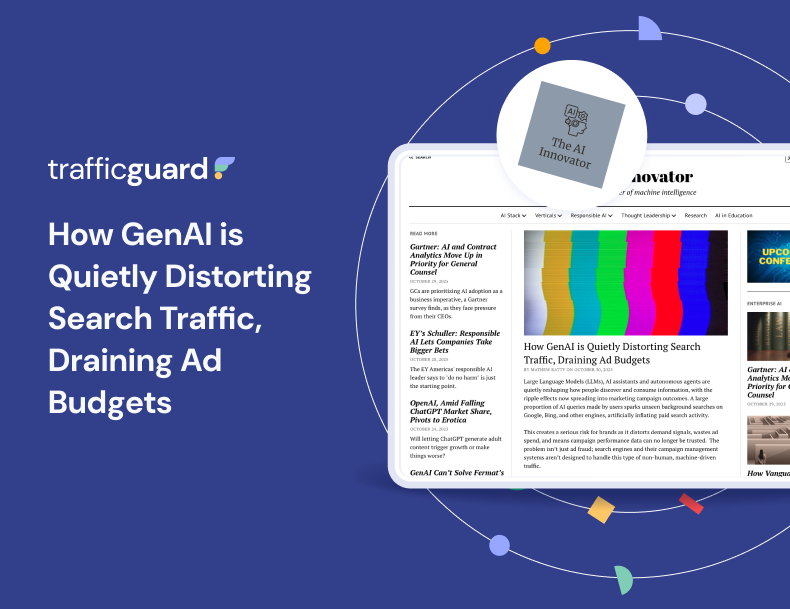TrafficGuard – fraud prevention for your digital advertising

This interview was first published by Website Planet.
Ad fraud, whether malicious or unintentional, can waste a significant part of a business’s ad spend on traffic that will never convert to true customers. Luke Taylor, Founder, and COO of TrafficGuard talks about their powerful platform for preventing ad fraud from infiltrating their campaigns, skewing performance metrics, and taking ad spend.
What is TrafficGuard?
TrafficGuard is fraud prevention and verification for digital advertising. We work with businesses globally to protect their ad spend across all channels, campaign types, mobile, and desktop. We are focused on helping brands prevent ad fraud from infiltrating their campaigns, skewing performance metrics, and taking ad spend.
By preventing ad fraud, businesses can drive advertising performance and make sure they only pay for genuine advertising engagement from people who have the potential to become customers.
TrafficGuard has a pretty unique vantage point where we analyze traffic across different channels (search, display, programmatic, performance, mobile app), different campaign types (CPM, PPC, install campaigns), and all stages of the advertising journey (impressions, clicks, installs, events). And we see ad fraud across all digital channels – including what might be considered premium channels like Google Ads. Wherever there is money in digital advertising, there is ad fraud: all channels and all geographies.
What is Ad Fraud and who benefits from it?
Ad fraud is invalid traffic that is generated intentionally with malicious intent. Perpetrators of ad fraud typically generate it to either sabotage the efforts of a business, or for financial gain. More broadly, invalid traffic comprises more than fraud to be any advertising engagement that is outside the target of your campaigns. For example, an ad campaign targeting the US might get clicks from users in Brazil if they happen to be using a VPN routing their traffic through a US IP. This traffic isn’t malicious, but it isn’t in target either and would, therefore, be considered invalid but not fraudulent.
One way ad fraud manifests can be your competitors clicking on your ads, either directly or by enlisting the services of a click farm. By draining your ad spend, they can get the top spot on the search results at a cheaper rate.
Another way is through publishers who sell advertising space on their sites. The more advertising engagement on their website, the more ads are shown, and the more they get paid. This incentivizes some publishers to buy bot traffic to engage with their site.
Crawlers and scrapers, both legitimate like Google crawlers and nefarious like those that scrape competitive intelligence from eCommerce sites, for example, also interact with advertising, attracting ad spend without any possibility of conversion.
TrafficGuard typically invalidates anywhere between 15% and 30% of our clients’ PPC traffic. Once they have protection in place, they can actively prevent that traffic from seeing their advertising so that their budget can go towards reaching real people.
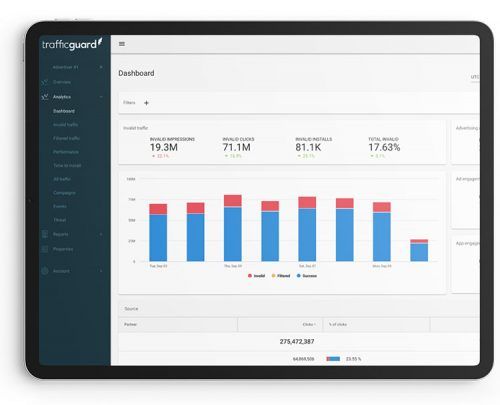
How does TrafficGuard protect against known and unknown fraud tactics?
TrafficGuard uses a variety of methods to detect known and unknown fraud tactics. Where practical and efficient, we use rules. One type of rule might be to stop traffic when we see the same user engaged with the same ad over and over in quick succession. We have an extensive rules library that facilitates the validation of each ad engagement.
TrafficGuard’s surgical approach utilizes behavioural analysis and device profiling to build an intricate profile of devices, IPs, traffic sources, site IDs, and other key characteristics over time. The profiles built around these characteristics, enrich the data we collect on each ad engagement to inform precise and reliable validation decisions.
With global operations across all campaign types, TrafficGuard analyses immense volumes of data. This helps us identify new trends and tactics quickly and reliably. TrafficGuard employs a combination of anomaly, classification, and predictive machine learning algorithms to analyze traffic and determine validity in real-time. This technique effectively blocks known and unknown types of fraud as they emerge. Each detection level feeds data back into TrafficGuard’s machine learning algorithms to help it get even stronger. Check out our guide to machine learning for fraud prevention to learn more about TrafficGuard’s approach.
What protections do you offer at each of the three levels – impression, click, and event?
Legacy solutions typically only analyze traffic at a single stage of the ad journey, such as the impression, click, or conversion. TrafficGuard is the first solution to analyze the full-funnel, enabling protection of various advertising types (CPM, CPC, CPI, CPA, etc.) at all three levels. Multi-point prevention also strengthens mitigation more generally because it receives more signals from more data at each stage of the advertising journey.
How does your PPC protection help companies get genuine ad engagements and higher conversions?
TrafficGuard uses all of the intelligence gathered across all of our ad fraud protection solutions to power our PPC fraud protection. With this product, we help businesses advertising on Google Ads to ensure that their ad spend delivers genuine engagement by proactively mitigating sources of invalid traffic in real-time.
By stopping ads from displaying to sources of invalid traffic, campaign budgets are then only spent showing ads to people that have the potential to become customers. Bots and invalid traffic have no potential to become customers for your business.
We have just launched a free tier for PPC protection where businesses can get visibility into their traffic quality and see where their opportunities are to improve their campaign by mitigating fraud.
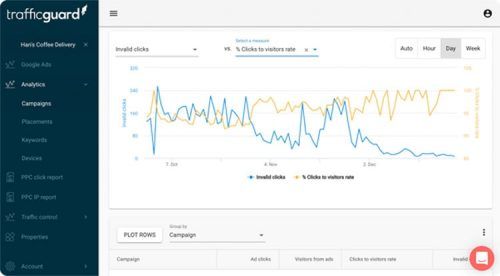
Check out TrafficGuard’s FREE PPC Protection
What type of pattern and trends might indicate ad fraud?
In light of COVID-19, it is especially hard for businesses to use their performance benchmarks as an indicator of fraud because they are being influenced by massive changes in consumer behaviour and consumer confidence because of the pandemic.
On top of that, ad fraud and bot traffic increasingly look like real human engagement, only it never really converts.
The reality is that if you don’t have fraud prevention, fraud is very likely to be impacting your campaigns. It isn’t something that will suddenly start and raise lots of red flags. It is likely already there and influencing your perception of your baseline Google Ads results. The only way to know for sure is to get specialist fraud prevention in place – and then you should see lower bounce rates, longer session times, and more conversions. All symptoms of more genuine, human traffic.
What type of user behaviour after installing an app might be suspicious?
For app install campaigns, some sophisticated bots are designed to create a level of engagement that resembles human behaviour. This might be to get to level 1 of your game, reach Day 3 retention, or perform some other function in the app. When this is the case, you might recognize behavioural trends in app installs from certain sub-sources or site-IDs like lots of drop off after the campaign’s conversion point.
How does TrafficGuard help drive campaign ROI with real app users?
If 25% of your traffic is currently ad fraud, that is a quarter of your budget that isn’t delivering any ROI at all.
When you stop ad fraud, that 25% can go towards real advertising engagement – that might be clicks for Google Ads or app installs for CPI campaigns etc. When real people engage with your ads, they have the potential to become customers and deliver advertising ROI.
How does TrafficGuard use Viewability, Pre-bid Optimization, and IVT Measurement?
At the Impression level, TrafficGuard first and foremost determines whether your ad is actually being displayed on the page – this helps advertisers to avoid paying for impressions when their ads weren’t viewable.
Impression level data also guides IVT measurement at the impression, helping us invalidate and verify impressions as the first line of defence, and strengthening fraud mitigation at later stages in the advertising journey.
Sources of low-quality traffic can then be optimized out, before impressions are bid, helping drive superior advertising performance.
What analytics and insights are available through TrafficGuard’s dashboard and reporting?
Our mission is to bring trust and transparency in digital advertising, which is reflected in multiple ways in our reporting. Firstly, we give you a really detailed picture of precisely which campaigns, ad groups, keywords, ads are receiving invalid traffic.
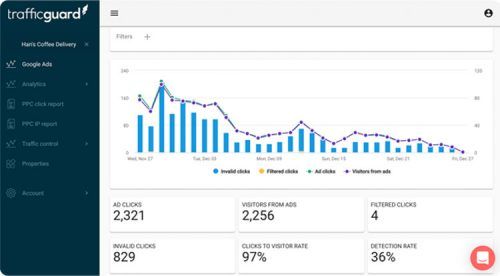
Most importantly, TrafficGuard is not a BlackBox. You can see every ad engagement and, if invalid, get granular visibility into invalidation reasons.
For advertising with ad networks, you can expose dedicated reporting so that everyone has access to consistent and reliable reporting to drive the best advertising performance.
Get started - it's free
You can set up a TrafficGuard account in minutes, so we’ll be protecting your campaigns before you can say ‘sky-high ROI’.
At TrafficGuard, we’re committed to providing full visibility, real-time protection, and control over every click before it costs you. Our team of experts leads the way in ad fraud prevention, offering in-depth insights and innovative solutions to ensure your advertising spend delivers genuine value. We’re dedicated to helping you optimise ad performance, safeguard your ROI, and navigate the complexities of the digital advertising landscape.
Subscribe
Subscribe now to get all the latest news and insights on digital advertising, machine learning and ad fraud.






